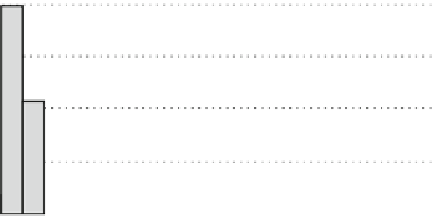Geoscience Reference
In-Depth Information
impact, and the diameter of the impacting object (Shoe-
maker
1983
). In this analysis, it is assumed that all of the
objects were iron asteroids with a density of 7.8 g cm
-3
,
and that they struck crustal material with a density of
2.65 g cm
-3
. In addition, the diameter of craters larger than
3 km has been adjusted upwards by a factor of 1.3 to
account for collapse due to gravity. It is possible to use
Eqs. (
9.6
) and (
9.8
) (Hills and Mader
1997
) to calculate the
hypothetical distribution of tsunami wave heights in the
ocean produced by this theorized population of impacts
over the last 225 million years. This distribution is plotted
in Fig.
9.7
at a distance of 1,000 km from each impact site.
All objects are assumed to have fallen into an ocean that is
5,000 m deep. Shallow water corrections have been applied
where required because they make the theorized tsunami
wave heights more realistic. For example, the Chicxulub
impact object, which had a postulated diameter as great as
15 km (Alvarez
1997
), would have generated a tsunami
4.6 km high without this correction, as opposed to one
104 m high with it. The latter value is closer to estimates
derived from analysis of sedimentary deposits laid down by
the wave. The average height of theorized, asteroid-gener-
ated tsunami waves in the ocean over the past 65 million
years is 12.6 m. If the cut-off value for mega-tsunami
begins at 5 m, then 40 % of impacts generated this type of
event. The probability of an asteroid producing a tsunami
more than 5 m in height over the next million years is
0.26 %. Since civilization began, the probability of such a
large event has only been 0.0026 %. Mega-tsunami greater
than 20 m in elevation are rare and represent in total 17 %
of hypothesized events. While the effect of mega-tsunami in
any ocean would be catastrophic, geologically, they do not
appear to have been a dominant force shaping world coastal
landscape. This poses a conundrum for the Late Holocene
epoch—beginning about 7000 years ago when sea level
reached present levels after the Last Glacial, because evi-
dence of mega-tsunami over this period is common.
40
30
20
10
0
0 0 0 0 0 0 0 0 0 0
Theorised tsunami height (m)
100
Fig. 9.7
Theoretical distribution of tsunami wave heights generated
by
iron
asteroid
impacts
with
the
world's
oceans
over
the
last
225 million years. Density of the meteorites is 7.8 g cm
-3
extinction event (Bourgeois et al.
1988
; Bohor
1996
; Smit
et al.
1996
).
The comet responsible for the extinction event was about
10-15 km in diameter, and produced a crater 180 km in
diameter in anhydrite-rich limestones and dolomites
(Verschuur
1996
; Alvarez
1997
; Koeberl and MacLeod
2002
). Two fireballs issued from the impact site. The first
consisted of a cloud of extremely hot vapourised rock,
followed closely by a superheated cloud of CO
2
gas
released from the carbonates. The heat was so intense that
all vegetation burned out to a radius of several thousand
kilometers, loading the atmosphere with soot. Seismic
waves with surface wave magnitudes, M
s
, of 9-11 caused
faulting in shallow waters around the Gulf. Huge submarine
landslides were triggered on steeper slopes. Following the
impact, Sunlight was blocked by an estimated 100 9 10
9
tonnes of dust thrown into the atmosphere—a process that
eliminated photosynthesis for a 2-6 month period. Large
amounts of CO
2
and SO
2
were released into the atmosphere
together with the formation of equivalent amounts of
nitrogen oxides. Subsequent scavenging of these molecules
from the atmosphere produced an acid rain rich in sulfuric
and nitric acids. All animals dependent upon photosynthe-
sizing organisms became extinct. In total, 38.5 % of all
genera and 67 % of all species disappeared. Only the end of
the Permian 250 million years ago saw the extermination of
more species.
The evidence for extinction is one of the main signatures
of the K/T event left in the geological record. However, the
presence of a homogenite unit 180 m thick in Cuba (Matsui
et al.
2002
) and tsunami deposits up to 9 m thick on con-
tinental shelves and the seafloor (Bohor
1996
) provide the
conclusive proof of an impact event of enormous magni-
tude. The impact occurred on the continental shelf, close to
the southern shore of the proto-Gulf of Mexico (Fig.
9.8
),
which formed an enclosed, shallow sea, 1,500 km in
diameter. Tsunami were generated by the ejecta curtain, the
9.4.2
Chicxulub, the Cretaceous-Tertiary (K/T)
Extinction Event
One of the great mysteries of geology, the extinction of the
dinosaurs, was not solved until 1980, when Walter Alvarez
and his colleagues proposed that a comet had caused a
global winter that not only killed the dinosaurs, but also
wiped out 67 % of all species at the boundary between the
Cretaceous and the Tertiary (Verschuur
1996
; Alvarez
1997
). That hypothesis was speculative until the crater for
the impact was eventually found underlying Chicxulub, on
the Yucatan Peninsula in Mexico. Finally, between 1988
and 1992, tsunami deposits were found in the region that
linked the Chicxulub crater to what is now called the K/T































